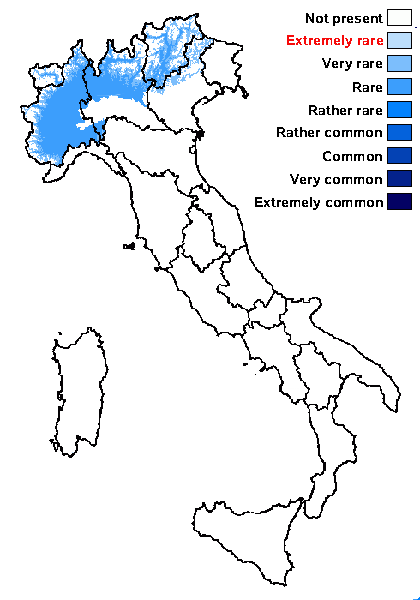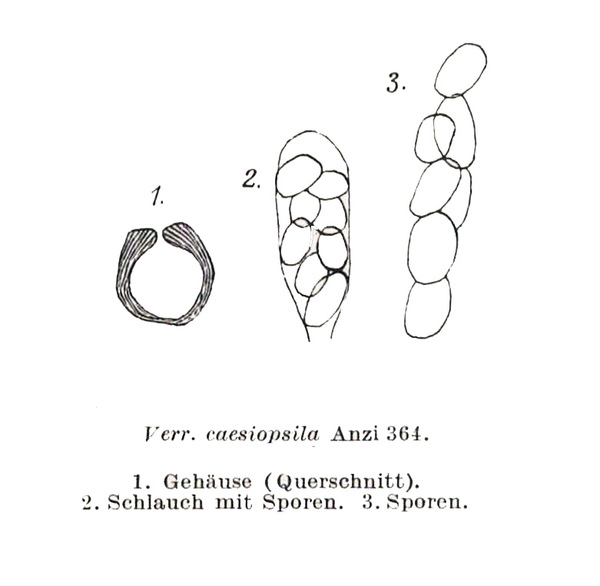Verrucaria caesiopsila Anzi
Comm. Soc. Critt. Ital., 2, 1: 23, 1864.
Synonyms: Amphoridium caesiopsilum (Anzi) Arnold; Verrucaria delitescens Servít ?; Verrucaria integrella (Hue) Nyl.
Distribution: N - Ven, TAA (Nascimbene & al. 2022), Lomb, Piem (Isocrono & al. 2004), VA (Piervittori & Isocrono 1999).
Description: Thallus crustose, endosubstratic, grey-white, usually inconspicuous and poorly evident, not radially fissured around the perithecia. Medulla without macrosphaeroids. Perithecia black, 0.15-0.25 mm across, totally or ¾ immersed in deep pits of the rock, only slightly projecting with the c. 0.2 mm wide, at first white- to bluish-pruinose, then black ostiolar region. Involucrellum absent; exciple subglobose, 0.25-0.3 mm across, the wall black throughout; hamathecium of periphyses and periphysoids measuring 30-40 x c. 2 μm, interascal filaments absent; hymenial gel hemiamyloid, I+ red (I+ blue at very low concentrations of I), K/I+ blue. Asci 8-spored, clavate, I-, fissitunicate, the wall thickened above, with an ocular chamber, dehiscent by extrusion of an endotunica to form a delicate rostrum, Verrucaria-type. Ascospores 1-celled, hyaline, ellipsoid, 17-23 x (9-)11-13(-14) μm. Photobiont chlorococcoid. Spot tests: K-, C-, KC-, P-, UV-. Chemistry: without lichen substances.
Note: a poorly known species of calcareous rocks (limestone and dolomite). The ecological indicator values are tentative.
Growth form: Crustose endolithic
Substrata: rocks
Photobiont: green algae other than Trentepohlia
Reproductive strategy: mainly sexual
Poorly known taxon in need of further study
Commonnes-rarity: (info)
Alpine belt: absent
Subalpine belt: absent
Oromediterranean belt: absent
Montane belt: very rare
Submediterranean belt: rare
Padanian area: absent
Humid submediterranean belt: absent
Humid mediterranean belt: absent
Dry mediterranean belt: absent

Predictive model

CC0-1.0 - Natural History Museum (2014). Specimens (from Collection specimens) [Data set resource]. Natural History Museum. https://data.nhm.ac.uk/dataset/collection-specimens/resource/05ff2255-c38a-40c9-b657-4ccb55ab2feb
syntype
Growth form: Crustose endolithic
Substrata: rocks
Photobiont: green algae other than Trentepohlia
Reproductive strategy: mainly sexual
Poorly known taxon in need of further study
Commonnes-rarity: (info)
Alpine belt: absent
Subalpine belt: absent
Oromediterranean belt: absent
Montane belt: very rare
Submediterranean belt: rare
Padanian area: absent
Humid submediterranean belt: absent
Humid mediterranean belt: absent
Dry mediterranean belt: absent

Predictive model

 INDEX FUNGORUM
INDEX FUNGORUM
 GBIF
GBIF
 DOLICHENS
DOLICHENS



